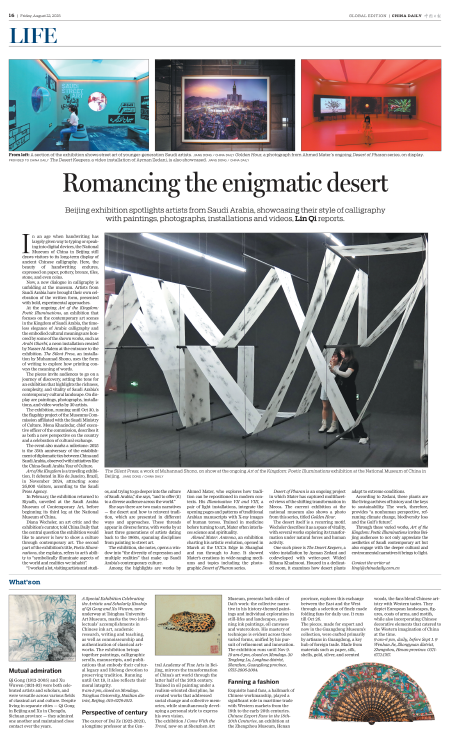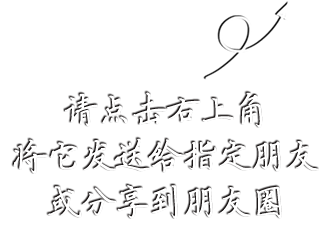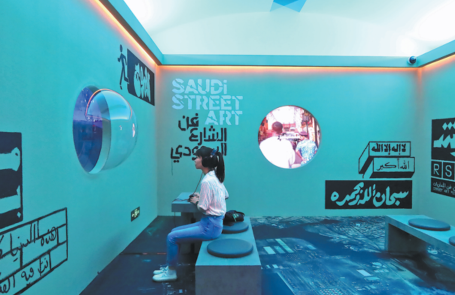
A section of the exhibition shows street art of younger-generation Saudi artists.
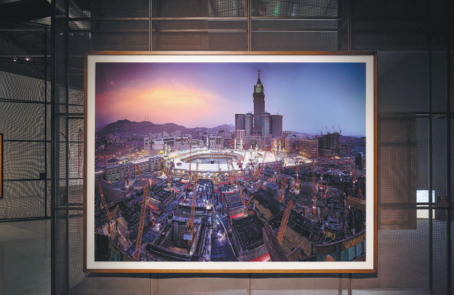
Golden Hour, a photograph from Ahmed Mater's ongoing Desert of Pharan series, on display.
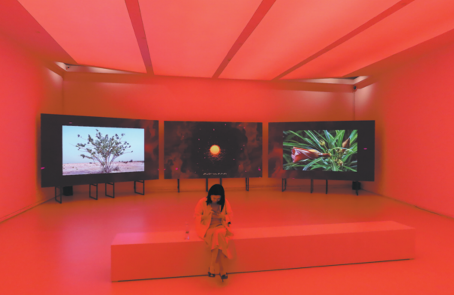
The Desert Keepers, a video installation of Ayman Zedani, is also showcased.
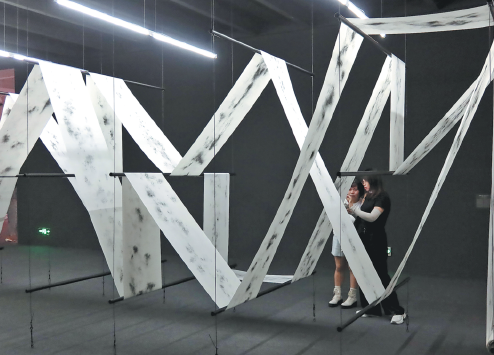
The Silent Press, a work of Muhannad Shono, on show at the ongoing Art of the Kingdom: Poetic Illuminations exhibition at the National Museum of China in Beijing.
In an age when handwriting has largely given way to typing or speaking into digital devices, the National Museum of China in Beijing still draws visitors to its long-term display of ancient Chinese calligraphy. Here, the beauty of handwriting endures, expressed on paper, pottery, bronze, tiles, stone, and even coins.
Now, a new dialogue in calligraphy is unfolding at the museum. Artists from Saudi Arabia have brought their own celebration of the written form, presented with bold, experimental approaches.
At the ongoing Art of the Kingdom: Poetic Illuminations, an exhibition that focuses on the contemporary art scenes in the Kingdom of Saudi Arabia, the timeless elegance of Arabic calligraphy and the embodied cultural meanings are honored by some of the shown works, such as Arabi Gharbi, a neon installation created by Nasser Al-Salem at the entrance to the exhibition. The Silent Press, an installation by Muhannad Shono, uses the form of writing to explore how printing conveys the meaning of words.
The pieces invite audiences to go on a journey of discovery, setting the tone for an exhibition that highlights the richness, complexity, and vitality of Saudi Arabia's contemporary cultural landscape. On display are paintings, photographs, installations, and video works by 30 artists.
The exhibition, running until Oct 30, is the flagship project of the Museums Commission affiliated with the Saudi Ministry of Culture. Mona Khazindar, chief executive officer of the commission, describes it as both a new perspective on the country and a celebration of cultural exchange.
The event also marks a milestone: 2025 is the 35th anniversary of the establishment of diplomatic ties between China and Saudi Arabia, observed with initiatives like the China-Saudi Arabia Year of Culture.
Art of the Kingdom is a traveling exhibition. It debuted in Rio de Janeiro, Brazil, in November 2024, attracting some 26,000 visitors, according to the Saudi Press Agency.
In February, the exhibition returned to Riyadh, unveiled at the Saudi Arabia Museum of Contemporary Art, before beginning its third leg at the National Museum of China.
Diana Wechsler, an art critic and the exhibition's curator, told China Daily that the central question the exhibition would like to answer is how to show a culture through contemporary art. The second part of the exhibition's title, Poetic Illuminations, she explains, refers to art's ability to "symbolically illuminate aspects of the world and realities we inhabit".
"I worked a lot, visiting artists and studios, and trying to go deeper into the culture of Saudi Arabia," she says, "and to offer (it) to a diverse audience across the world."
She says there are two main narratives — the desert and how to reinvent tradition, which are presented in different ways and approaches. These threads appear in diverse forms, with works by at least three generations of artists dating back to the 1960s, spanning disciplines from painting to street art.
The exhibition, she notes, opens a window into "the diversity of expression and multiple realities" that make up Saudi Arabia's contemporary culture.
Among the highlights are works by Ahmed Mater, who explores how tradition can be repositioned in modern contexts. His Illumination VII and VIII, a pair of light installations, integrate the opening pages and patterns of traditional Arabian manuscripts with X-ray images of human torsos. Trained in medicine before turning to art, Mater often interlaces science and spirituality.
Ahmed Mater: Antenna, an exhibition charting his artistic evolution, opened in March at the UCCA Edge in Shanghai and ran through to June. It showed Mater's creations in wide-ranging mediums and topics including the photographic Desert of Pharan series.
Desert of Pharan is an ongoing project in which Mater has captured multifaceted views of the shifting transformation in Mecca. The current exhibition at the national museum also shows a photo from this series, titled Golden Hour.
The desert itself is a recurring motif. Wechsler describes it as a space of vitality, with several works exploring its transformation under natural forces and human activity.
One such piece is The Desert Keepers, a video installation by Ayman Zedani and codeveloped with writer-poet Wided Rihana Khadraoui. Housed in a dedicated room, it examines how desert plants adapt to extreme conditions.
According to Zedani, these plants are like living archives of history and the keys to sustainability. The work, therefore, provides "a nonhuman perspective, reframing climate change, biodiversity loss and the Gulf's future".
Through these varied works, Art of the Kingdom: Poetic Illuminations invites Beijing audiences to not only appreciate the aesthetics of Saudi contemporary art but also engage with the deeper cultural and environmental narratives it brings to light.
Contact the writer at linqi@chinadaily.com.cn
